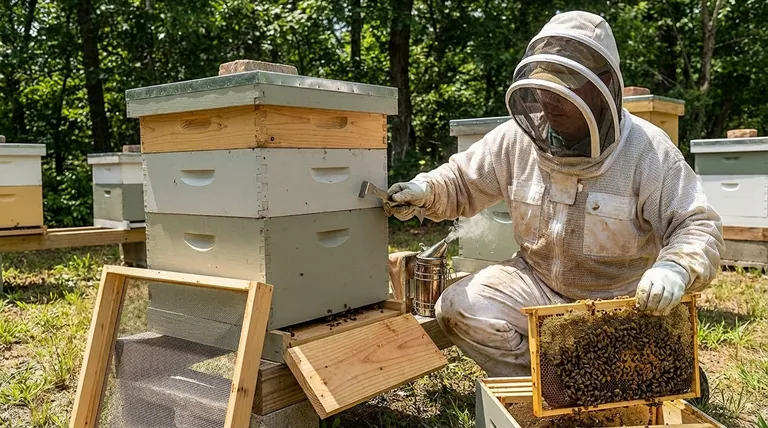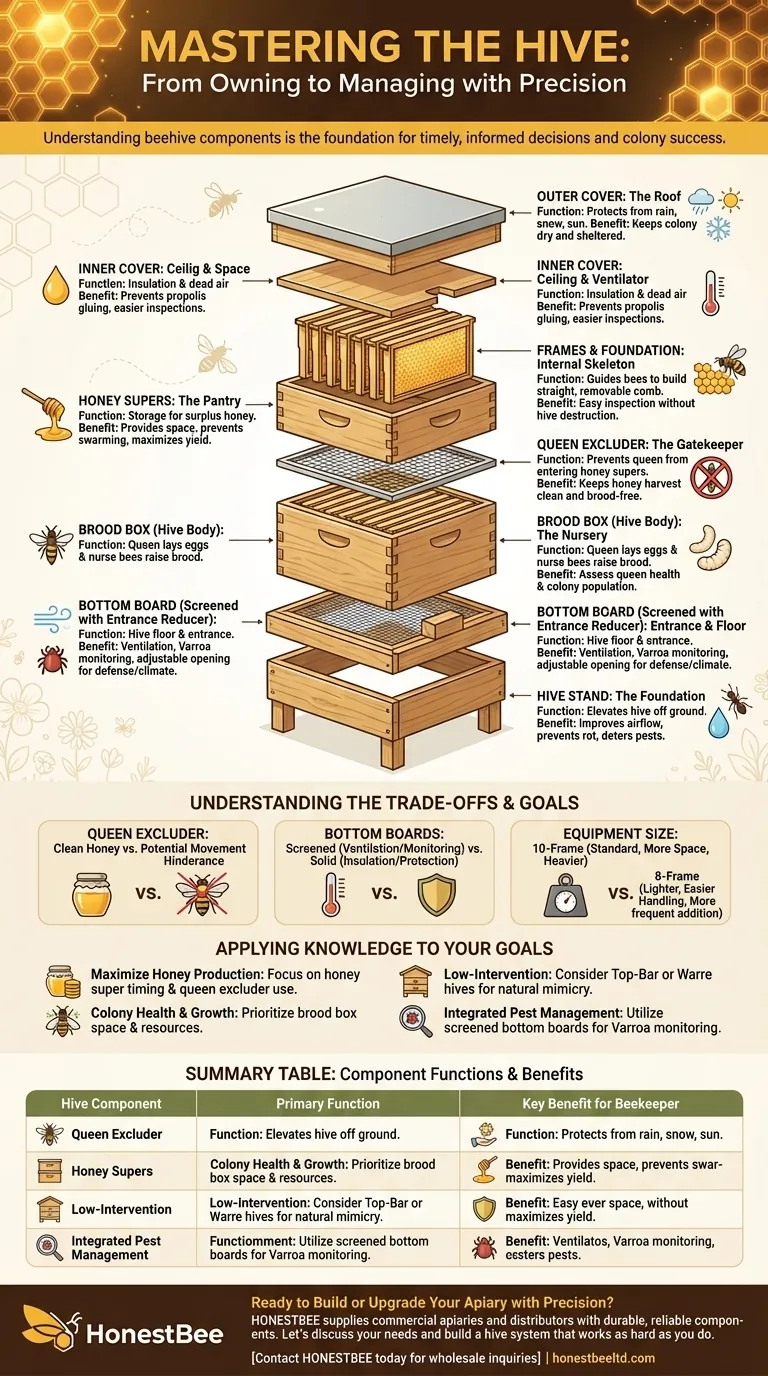Fundamentally, understanding each part of a beehive is the difference between simply owning bees and truly managing them. This knowledge is the foundation for making timely, informed decisions that directly impact the health, productivity, and survival of your colony. It transforms hive components from a simple wooden box into a system you can read, interpret, and adjust with purpose.
Knowing the function of each hive component transforms you from a passive observer into an active manager. It allows you to "read" the colony's health, anticipate its growth, and perform manipulations with precision and confidence.

Deconstructing the Beehive: A Functional Guide
A modern beehive, most commonly the Langstroth hive, is a modular system. Each component serves a distinct purpose that caters to the natural biology of honey bees while enabling the beekeeper to manage the colony effectively.
The Hive Stand: The Foundation
A hive stand elevates the entire structure off the ground. This simple act provides critical benefits, including improved airflow to reduce moisture, protection for the wooden components from ground rot, and a defense against crawling pests like ants.
The Bottom Board: The Entrance and Floor
The bottom board serves as the hive's floor and entrance. Beekeepers often use an entrance reducer, a small wooden block, to adjust the size of the opening. This helps a small colony defend itself or protects the hive from cold drafts in winter. Many beekeepers now use a screened bottom board for ventilation and for monitoring Varroa mite populations.
The Hive Body (Brood Box): The Nursery
This is the heart of the colony. The deep hive bodies make up the brood chamber, where the queen lays her eggs and the nurse bees raise the next generation of bees (the brood). During an inspection, this is where you look to assess the queen's health and the colony's population.
The Queen Excluder: The Gatekeeper
This is a flat grid of wire or plastic with openings large enough for worker bees to pass through but too small for the larger queen. When placed between the brood box and the honey supers, it ensures the queen cannot lay eggs in the frames designated for honey collection, making the harvest process much cleaner.
The Honey Super: The Pantry
These are the boxes, typically shallower than hive bodies, stacked on top of the brood chamber. Their sole function is for the bees to store surplus honey. Adding supers at the right time is critical to give the bees space to store nectar, which in turn prevents the colony from feeling crowded and deciding to swarm.
Frames and Foundation: The Internal Skeleton
Inside each box are removable frames. These frames usually hold a sheet of foundation (beeswax or plastic) imprinted with a honeycomb pattern. This foundation gives the bees a guide for building straight, orderly comb, which is the single most important innovation in modern beekeeping as it allows for the inspection of brood and resources without destroying the hive.
The Inner Cover: The Ceiling and Ventilator
The inner cover sits on top of the uppermost box. It provides a layer of dead air for insulation and often has a notched opening that can serve as an upper entrance or for ventilation. It prevents the bees from gluing the outer cover to the hive body with propolis, making inspections easier.
The Outer Cover: The Roof
Also called a telescoping cover, this is the hive's roof. It fits over the inner cover and top box, protecting the entire colony from rain, snow, and sun. Its primary job is to keep the colony dry and protected from the elements.
Understanding the Trade-offs
Choosing and using hive components involves balancing different management goals. There is rarely one "perfect" setup, only the one that is best for a specific situation.
The Queen Excluder Debate
While a queen excluder ensures brood-free honey, some beekeepers argue it can hinder the movement of worker bees, potentially reducing honey production. They believe it creates an artificial barrier and prefer to manage the brood nest without one, accepting that some brood may appear in honey frames.
Solid vs. Screened Bottom Boards
A screened bottom board is excellent for ventilation in hot climates and allows for easy monitoring of Varroa mites, which fall through the screen. However, in cold climates, a solid bottom board provides better insulation and protection from winter winds. Many beekeepers switch between the two depending on the season.
8-Frame vs. 10-Frame Equipment
The 10-frame hive is the traditional standard, offering more space for brood and honey. However, a fully loaded 10-frame deep box can weigh over 80 pounds. An 8-frame hive is lighter and easier to handle, making it a popular choice for beekeepers who wish to avoid heavy lifting, though it requires adding new boxes more frequently.
Applying This Knowledge to Your Goals
Your beekeeping objectives will determine which components you focus on most.
- If your primary focus is maximizing honey production: You must master the timing of adding honey supers and the strategic use of a queen excluder to keep your honey frames clean.
- If your primary focus is colony health and population growth: Your attention will be on the brood boxes, ensuring the queen has ample space to lay and the colony has sufficient resources to expand.
- If your primary focus is simple, low-intervention beekeeping: You might choose a hive style like a Top-Bar or Warre hive, which use different components to more closely mimic a natural bee cavity.
- If your primary focus is integrated pest management: Understanding the function of a screened bottom board is your most valuable tool for passively monitoring Varroa mite levels without disrupting the colony.
By learning the language of the hive's components, you gain the ability to listen to your bees and respond to their needs with confidence.
Summary Table:
| Hive Component | Primary Function | Key Benefit for Beekeeper |
|---|---|---|
| Hive Stand | Elevates hive off the ground | Prevents rot, deters pests, improves ventilation |
| Bottom Board | Serves as the hive's floor and entrance | Allows use of entrance reducers for defense/weather protection |
| Brood Box | Nursery for the queen to lay eggs and raise brood | Enables assessment of queen health and colony population |
| Queen Excluder | Prevents queen from entering honey supers | Keeps honey harvest clean and brood-free |
| Honey Super | Storage for surplus honey | Provides space to prevent swarming and maximize honey yield |
| Frames & Foundation | Guides bees to build straight, removable comb | Allows for easy inspection without destroying the hive |
| Inner & Outer Cover | Provides insulation and weather protection | Keeps colony dry and makes inspections easier |
Ready to Build or Upgrade Your Apiary with Precision?
Understanding your hive is the first step; having the right, high-quality equipment is the next. HONESTBEE supplies commercial apiaries and beekeeping equipment distributors with the durable, reliable components discussed in this article—from sturdy hive stands and screened bottom boards for integrated pest management to efficient honey supers and frames.
We help you make informed decisions that align with your specific goals, whether it's maximizing honey production, ensuring colony health, or streamlining your operations.
Let's discuss your needs and build a hive system that works as hard as you do.
Contact HONESTBEE today for wholesale inquiries
Visual Guide

Related Products
- HONESTBEE Advanced Ergonomic Stainless Steel Hive Tool for Beekeeping
- HONESTBEE Professional Long Handled Hive Tool with Precision Cutting Blade
- Multi-Function Hive Tool with Integrated Hammer for Beekeeping
- Professional Galvanized Hive Strap with Secure Locking Buckle for Beekeeping
- Wholesales Dadant Size Wooden Bee Hives for Beekeeping
People Also Ask
- What are some common uses of a hive tool? Essential Multi-Purpose Tool for Every Beekeeper
- What are the basic tools for beekeeping? Essential Starter Kit for Safe & Successful Hive Management
- What are the features of a regular hive tool? The Essential Multi-Tool for Every Beekeeper
- What is the hole in a hive tool for? A Multi-Tool for Apiary Repairs and Maintenance
- What tools are used for cleaning frames? A Beekeeper's Simple 4-Tool Guide



















